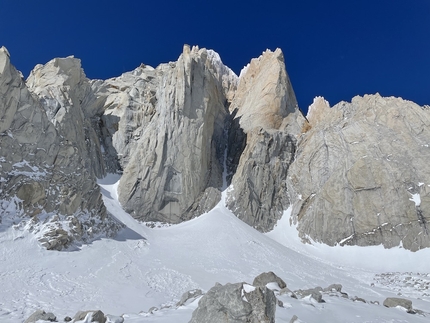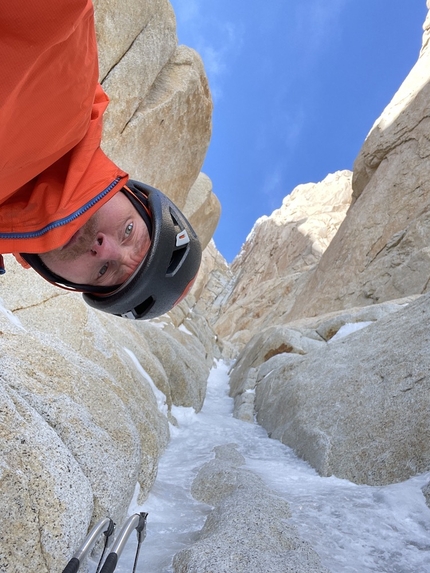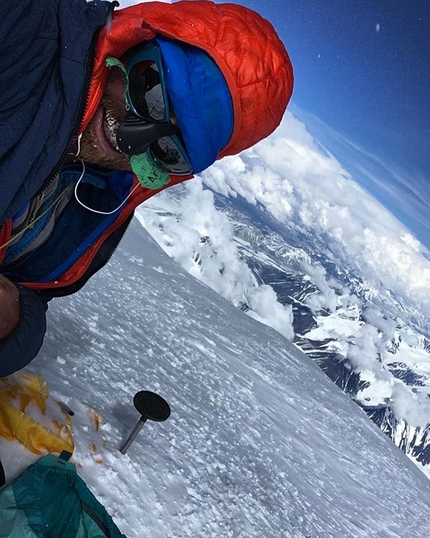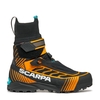Colin Haley and his Fitz Roy Supercanaleta winter solo

 1 / 9
1 / 9 Colin Haley
Colin Haley
In late September 2022 Colin Haley completed the first winter solo of the classic Supercanaleta route on Fitz Roy in Patagonia. First ascended in 1965 by the Argentineans Carlos Comesaña and José Luis Fonrouge, this 1600m line is recognised as one of the premier mixed climbs in the Fitz Roy massif and one of the most sought-after objectives in Patagonia.
Haley had climbed Supercanaleta three times previously - including the route’s second solo in summer 2009 after Dean Potter completed the first in 2002 - and after bivying below the face he climbed and descended the route in a 21.5 hour-push between the 19th and 20th of September. Four months on, it’s worth finding out a little more about the experience which the 38-year old described as "pretty darn badass."
Nice one Colin! Sounds like you laid a nine year dream to rest. Or was it perhaps an obsession?
Certainly not an obsession, and it might even be overstating things to call it a nine year dream. It is true that it is an objective that had been in my mind for nine years, but that is not so abnormal for me. I daydream about climbing objectives all the time, so there are lots of climbing objectives that I have been pondering for years. In this case I had made a previous trip to Patagonia to try this specific objective, so that qualifies it as being an ambition I was more invested in.
Why Supercanaleta? What makes it so special?
The Supercanaleta is one of the most classic and obvious routes in the Chalten Massif, and the name is very descriptive - it really is a super couloir! The couloir itself is something around 1,400m of elevation gain, and it is pretty much perfectly straight the whole way. The fact that it is on such an iconic mountain with no easy routes to the summit certainly adds to the appeal. In addition to the fact that the Supercanaleta is an awesome route in general, it is an obvious objective to consider trying in winter, because even in summer it is a route typically climbed entirely in crampons. A route like Chiaro di Luna (on Aguja St. Exupery) is in general a much easier climb than Supercanaleta, but is normally climbed entirely in rock shoes, and unless it was an abnormally warm, dry winter, would become much, much harder to climb in boots and crampons. So, a route like Chiaro di Luna would be a much less obvious choice in winter.
You noted "It was a very intense experience that leveraged the total skillset I have built up over the past 22 years of climbing and alpinism. The climb and descent left me wasted physically, mentally, and psychologically." Is this in some ways your magnum opus?
Sorry to give you an anticlimactic answer, but, no, this is definitely not my magnum opus. This is probably among my top ten climbing achievements though, and certainly among the top fifteen. The words I wrote are totally accurate, but perhaps they gave too strong an impression.
Before your solo, you had climbed the route 3 times previously. Knowing the route well, what were you worried about?
My main concern was the most obvious one - of falling to my death! I free-soloed about 97% of the route, and on that other 3% I was using some techniques that are only barely safer than free-solo, so you still really, really don't want to fall off. On the other hand, because I was planning to descend by the same route, I at least knew that I could fairly reasonably bail from any point (although from some spots it would be more epic than from others), and that definitely takes some pressure off.
Before we delve into your winter solo: a quick glance at your summer solo photos make it clear that your 2009 summer ascent wasn’t particularly summery!
No, not at all. My solo ascent in 2009 was done during a very marginal weather window. That remains one of the most difficult and intense days of my life. It definitely felt way more difficult and intense than my winter solo - not because it was actually more difficult (or even as difficult), but because I'm a massively better climber now than I was in 2009, and with massively more experience. While I was up on the Supercanaleta on this trip, especially on my first attempt, I actually felt kind of blown away by what I had done back in 2009.
Before your successful solo, you backed off an attempt and vowed you’d never try to solo it again. A few days later though you ignored that promise completely
When I made the attempt, the whole experience felt too stressful and scary, although in hindsight that might be partly because it had been a long time since I'd done any hard solo ascents. When you've just gotten down from a stressful, scary experience, it is hard to imagine wanting to have another experience like that. However, a few days later, down in the relative comfort and safety of the lowlands, it is easy to start dreaming again of the objective, and of casting out again into the intensity. Of course it's not logical at all, but I'm sure that many other alpine climbers could relate to what I'm saying.
How much gear did you take?
In terms of climbing hardware I had a 60m twin rope, a 65m dyneema rappel rope, a single set of cams, a single set of nuts, ten pitons, two ice screws, and a healthy selection of slings and carabiners. I didn't use the majority of that hardware, and especially could've gone without almost all the pitons and most of the slings. That is security though. If, for some reason, I had to bail from a couple pitches below the notch, then I would have had to make a whole bunch of anchors rappelling down steep, virgin terrain. If I had gotten a rope stuck while rappelling, and had to make only short rappels, I would have been happy for every bit of hardware that I carried. In alpine climbing I almost always carry more pitons than I envision using, but I think that it is usually a wise insurance policy. Obviously I had crampons, axes, helmet, and harness. Aside from climbing hardware, I carried three liters of water, a bunch of energy food, an inReach, and little stuff like tape, sunglasses, knife, etc. In addition to fleece baselayers and hardshell layers, I had puffy belay pants, two puffy vests, two puffy jackets, two balaclavas, and three pairs of gloves.
Have fast did you hope to go?
I didn't have a specific hope in terms of time, but I wasn't taking any bivouac gear, and only three liters of water, so taking longer than 30 hours roundtrip would start to get epic. The time it took me, a little under 22 hours roundtrip, is roughly what I expected.
Did anything surprise you?
The only thing that really surprised me was coming across sections of thigh-deep powder snow on the final slopes below the summit. It's only surprising because it is really rare to have such deep snow so high on the mountain - normally it would be blown away by the wind.
Where did you free solo? And rope-solo?
I free-soloed about 97% of the route, and didn't do any real self-belaying. In six spots I did a "back loop," and in several other spots I did some "daisy soloing." Both of those techniques are really dubious and not safe. They could, however, potentially save your life, and thus are safer than free-soloing, in which any fall means certain death. So, those are techniques to be employed when the climbing is only slightly too hard to want to free-solo, but when you are still extremely confident that you won't fall. I really, really would not want to ever take a fall with either of these dubious systems.
So can you walk us through the upper section of the route? From where it breaks off rightwards all the way to the top, that sounds gnarly, in particular alone and in winter.
It is basically a lot of granite mixed climbing, mostly easy, but with lots of harder bits here and there. One thing worth noting is that climbing solo often changes what the cruxes are. For me, one of the crux sections was still in the gully, before branching off rightwards. Physically it is pretty easy, but kind of slabby and insecure, so a major crux for soloing. By contrast, a lot of the cruxes higher on the ridge are steeper and more physical, but with much more secure climbing, on good cracks, hence easier for solo climbing.
What relationship did you have with the mountain Colin?
Ha. I'm a pretty scientific sort of person. I don't know what it means to be "at one," or to have a relationship with a mountain. Certainly I was very alone though! There is no easy way off of Fitz Roy, and being on the summit alone, in winter, with no one else even on any of the nearby peaks, definitely felt like a very serious situation. On the summit I felt extremely anxious, and just totally focused on getting down safely.
You stashed a rope on the way up, figuring you didn’t need it for the first 200m rappel. A small detail that made a big difference?
Yes, it wasn't until after my first attempt that I came up with that plan. It worked out perfectly and I think it was the best strategy. I had briefly pondered the option of making my attempt over multiple days with a bivouac at the Bloque Empotrado, but I'm glad that I didn't. I think that my one-day strategy was a lot more efficient.
The descent sounds straightforward, but it’s absolutely huge. Going down alone, at night, does that amplify things?
Actually, assuming you have enough rope and hardware, rappelling is one of the few aspects of solo climbing that isn't much harder by yourself than with a partner. Of course you have no one else to double-check anything, and you aren't able to leave anchor back-ups for the second climber to remove, but that doesn't make a big difference. Making 1000m of alpine rappelling at night is of course no simple task, but I am extremely used to it. I have done a huge amount of climbing in the Chalten massif, more than anyone else I'm pretty sure, and there are almost no walk-offs in the Chalten massif, so I think I really am an expert at rappelling a lot of steep, alpine terrain!
How much were you willing to risk for this climb and - looking back now - how in control were you throughout the ascent?
It is really difficult to quantify these things. In general, I consider myself a very conservative climber, even though that may seem surprising to many people. I have redpointed 8b+, but it is very rare for me to free solo anything harder than 6a. I think that on this climb I was risking more than I do in most day-to-day alpine climbing around Chamonix, but not by a large amount. Taking bigger risks is always an easier path to success in alpine climbing, but I try to avoid that shortcut as much as I can. I think that my success on this climb was thanks to a huge amount of prior experience and skill building, patience and determination, and luck with the weather, but not so much thanks to risk taking.
Was anything or anyone else instrumental in your success?
My girlfriend and Rolo Garibotti were both sending me updated weather forecasts by satellite text message. I think if I had simply seen the last forecast before departing down, as I used to always do in Patagonia, probably I still would have succeeded. However, hearing an updated forecast the evening before climbing, especially one saying the weather should stay calm for the duration of my planned climb, with even time to spare... that definitely was a big confidence boost.
How different does the Supercanaleta feel to big solo climbs in the Alps?
Well, I haven't done much hard soloing in the Alps, and I'd say actually that I know the Chalten Massif quite a bit better than I know the Massif du Mont Blanc. I've soloed the north face of Les Droites by Le Ginat, and I've soloed Mont Blanc du Tacul by the Supercouloir. Those are certainly much easier and less serious than the Supercanaleta. But even a climb that is more comparable in difficulty, like the Colton-MacIntyre or Walker on Jorasses, I'd say would feel much easier overall. That is partly because most mountains in the Alps have a fairly easy way off from the summit, partly because the approaches are much shorter, partly because the weather windows are longer, partly because rescue is usually a possibility in the Alps (and almost never a possibility in the Chalten Massif), and partly because there are huts, more people, phone service, etc.
You’ve made a name for yourself for impressive repeats and linkups. But not so much for new routing in Patagonia. Is this a fair representation? How come?
Well, I've climbed eight significant new routes in the Chalten Massif, but nonetheless it is a fair representation. None of those eight new routes would be among even my top fifteen climbing achievements in the Chalten Massif. I am motivated by difficult objectives, and I am motivated by particularly aesthetic objectives. It is much more exciting to me to try a really difficult objective that isn't a new route than a new route that isn't particularly difficult. That isn't to say that I am opposed to climbing new routes. For sure climbing new terrain always has some magical mystery to it, and some lines are just really awesome lines that are exciting. For example, a couple new routes went up on the south face of Fitz Roy in recent years, the Colorado Route and La Chaltenense, that I would have been really stoked to do the first ascent of, because they are big, beautiful routes, that aren't contrived at all (although in the case of La Chaltenense, I probably would not have been up for leading it!). Also the English Dihedral on the east face of Cerro Torre, that was mostly climbed by Matteo Della Bordella and company last year, is a totally gorgeous, awesome, dream line. Sometimes though it seems that people simply are in search of putting up a new route, and care about that more than about climbing a particularly awesome route. Climbing the twelfth new route on the west face of Guillaumet, up a dihedral system 10 meters to the right of one existing route and 10 meters to the left of another existing route - that sort of thing feels less inspiring to me, and more contrived.
What or who has impressed and inspired you in the past?
There are so many! In recent years, my experiences climbing with Alex Honnold have scared me at times, but they also have really impressed me. A couple times in Patagonia I have followed Alex up lead blocks on rock climbing sections that really blew me away. Sean Villaneuva's solo Fitz Roy traverse also impresses me immensely. I have done a ton of solo climbing in the Chalten Massif, so I think I know better than almost anyone else how crazy it was that Sean pulled that off. There are so many added difficulties of solo climbing that you wouldn't necessarily think of, and that is a very complex objective to tackle by yourself.
Over the course of my life there have been so many ascents and climbers that have inspired me, especially if we include people from completely different eras, like Andreas Heckmair, Herman Buhl, Walter Bonatti, Renato Casarotto, etc. There are really far too many to name. But from the generation just before me, I'd say that people such as Marko Prezelj, Rolo Garibotti, Bruno Sourzac, Steve House, and Valery Babanov have been particularly inspiring with their climbing. I'm lucky to have met all of those legends, and had the pleasure of climbing with a few of them.
Haley thanks Petzl, SCARPA, Patagonia
Link: colinhaley.com



 Copia link
Copia link






 See all photos
See all photos


























